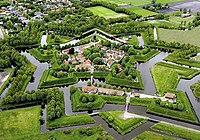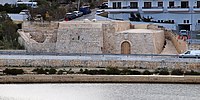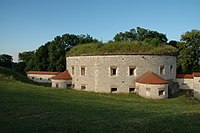Key:defensive_works
 |
| Description |
|---|
| Military constructions or buildings designed for the defence of territories in warfare |
| Group: military |
| Used on these elements |
| Documented values: 3 |
| Useful combination |
| See also |
|
| Status: approved |
| Tools for this tag |
|
This key is used to tag individual defensive structures mainly at historic/pre-modern ![]() fortifications. It is intended for all structures that were built for the defence of territories in warfare. This includes fortified settlements as well as forts that are/were uninhabited during peacetime.
fortifications. It is intended for all structures that were built for the defence of territories in warfare. This includes fortified settlements as well as forts that are/were uninhabited during peacetime.
Values for defensive_works=* contain terms used in fortification engineering.[1][2][3][4][5]
How to map
Individual defensive works should be mapped as ![]() Nodes at their centre, as
Nodes at their centre, as ![]() Ways along a centre line or as
Ways along a centre line or as ![]() Areas along the outlines. The best fitting method depends on the size and shape of the structure. They should be tagged with defensive_works=* and may receive additional tags.
Areas along the outlines. The best fitting method depends on the size and shape of the structure. They should be tagged with defensive_works=* and may receive additional tags.
Mappers are encouraged to combine this tag with other tags where they are relevant. If a structure is actively used by the military, it is recommended to add a military=* tag to it.
Tagging
Tags to use in combination
- name=* - if a defensive structure is named. Do not use the name of the fortification to tag individual structures.
- heritage=* - if the structure has a heritage status. If only the entire fortification has a heritage status, do not use heritage tags for individual structures.
- building=bunker - if the structure is a
 bunker
bunker - start_date=* - year of completion
- abandoned=yes - if the structure has been abandoned and shows signs of decay
- ruins=yes - if the structure is in ruins
- barrier=city_wall
- barrier=sally_port
- barrier=tank_trap
- bunker_type=*
- historic=cannon
- historic=castle_wall
- historic=city_gate
- historic=citywalls
- historic=fort
- military=trench
- tower:type=defensive
- wall=castle_wall
- water=moat
Diagrams
-
Star fort
-
Glacis
-
Counterguard and couvreface
-
A bastion with three cavaliers
-
Curtain walls of a bastion fort
-
A crownwork (A) and a lunette (B)
-
 Redan and flèche
Redan and flèche
References
- ↑ https://www.angelfire.com/wy/svenskildbiter/madict.html
- ↑ https://books.google.nl/books?id=6gc0AQAAMAAJ&pg=PR41-IA1#v=onepage&q&f=false
- ↑ https://books.google.nl/books?id=AUFYAAAAcAAJ&pg=PP3#v=onepage&q&f=false
- ↑ https://en.wikipedia.org/wiki/List_of_established_military_terms#Engineering
- ↑ https://en.wikipedia.org/wiki/Category:Fortification_(architectural_elements)
- ↑ https://books.google.nl/books?id=6gc0AQAAMAAJ&pg=PA122































